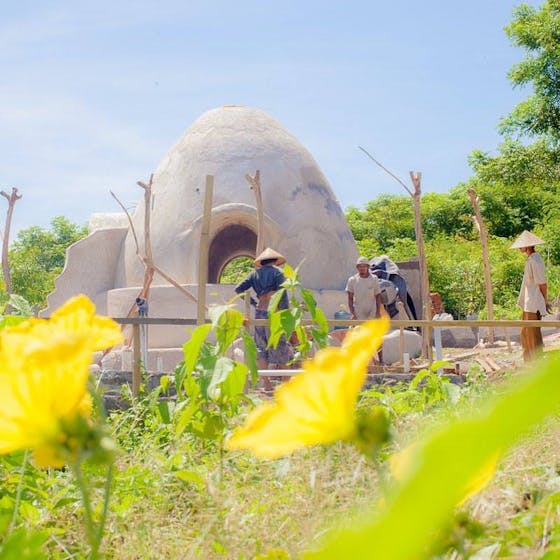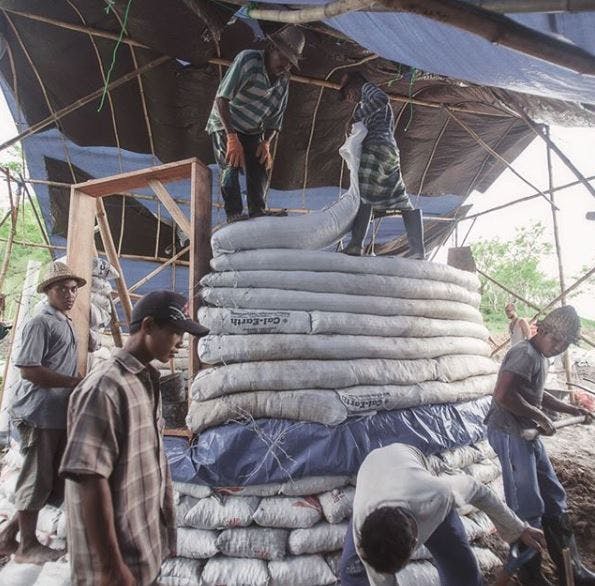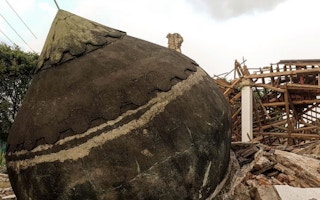Domes are simple, eco-friendly and, best of all, earthquake-proof—which is why communities in Northern Lombok that have lost their homes in a recent earthquake are rebuilding them as ‘eco-dome’ houses.
To continue reading, subscribe to Eco‑Business.
There's something for everyone. We offer a range of subscription plans.
- Access our stories and receive our Insights Weekly newsletter with the free EB Member plan.
- Unlock unlimited access to our content and archive with EB Circle.
- Publish your content with EB Premium.
As the name suggests, the houses made of earthbags—a mixture of compacted earth, sand and gravel—are topped off with a dome-shaped roof. Each eco-dome house can fit up to eight people and will have rainwater collection features.

An eco-dome in the Dome Lombok Eco-Village in Gerupuk, Southern Lombok. Domes are finished with natural lime stone plaster, with extra eco-friendly features like solar power, rainwater collection and water recycling systems.
Domes are durable structures that are extremely resistant to earthquakes, fires and floods, says Ghazal Amini, architect and project manager of Dome Lombok Eco-Village, a resort being constructed on the southern part of the island. While not yet operational, the site was spared the worst of the 6 August earthquake, but their northern counterparts were not as lucky.
The resort’s staff of British architects, Swedish investors and international volunteers have decided to lead efforts to teach three villages in Northern Lombok how to build dome-shaped houses, starting with Pemenang village this week.
“We will share the skills, knowledge and materials the villagers need to build their houses as eco-dome houses. The most important thing now is that we provide them with shelter, so they will feel safe to live inside again,” Amini says.
Amini’s team is creating sample structures to teach villagers the right building techniques, who then pass the knowledge on to other members of the community.
A step-by-step guide to building eco-domes in Bahasa Indonesia is also in the works. Each eco-dome can be completed in three weeks by five to 10 workers, and a home for a family of five costs 8 million Indonesian Rupiah or US$550, which is cheaper than using traditional construction materials such as brick and cement.
Dome Lombok Eco-Village’s team will build and fund one eco-dome house in each village, and provide guidance and support in design, material supplies and knowledge as the villagers build the rest of the homes.
More than 50,000 houses were destroyed and 350,000 people forced to evacuate to makeshift camps after a 7.0 magnitude earthquake rocked Lombok last month. With the rainy season just two months away, providing safe homes to victims of the disaster is an urgent priority. Across the three villages the team is helping in North Lombok, there have been 600 houses destroyed.
Within its own compound, the eco-resort is building dome-shaped houses as accommodation for guests and has completed the first, which comes with solar panels and a rainwater harvesting system.
“We have been building earthbag domes primarily for their eco-friendly design. However with the knowledge that the domes are also extremely earthquake resistant, we have to spread the word on this building method,” says Dome Lombok Eco-Village’s marketing and campaigns manager Anna Drost.
The most important thing now is that we provide people with shelter, where they will feel safe to live inside again.
Ghazal Amini, architect and project manager, Dome Lombok Eco-Village
While the Indonesian government has also promised 50 million Indonesian rupiah to each family to rebuild their houses, the group has also started an appeal for donations in a crowdfunding site, aiming to raise 20,000 British pounds.

Earthbags that make up the eco-domes are filled with materials that are organic and locally available.
“We want to teach people in Lombok how to build earthquake-resistant houses so that people can feel safe and normal life can resume.”
“We know there will be another quake in Lombok, but we don’t know whether it will be tomorrow, next week, next year or 100 years from now,” says Drost.








